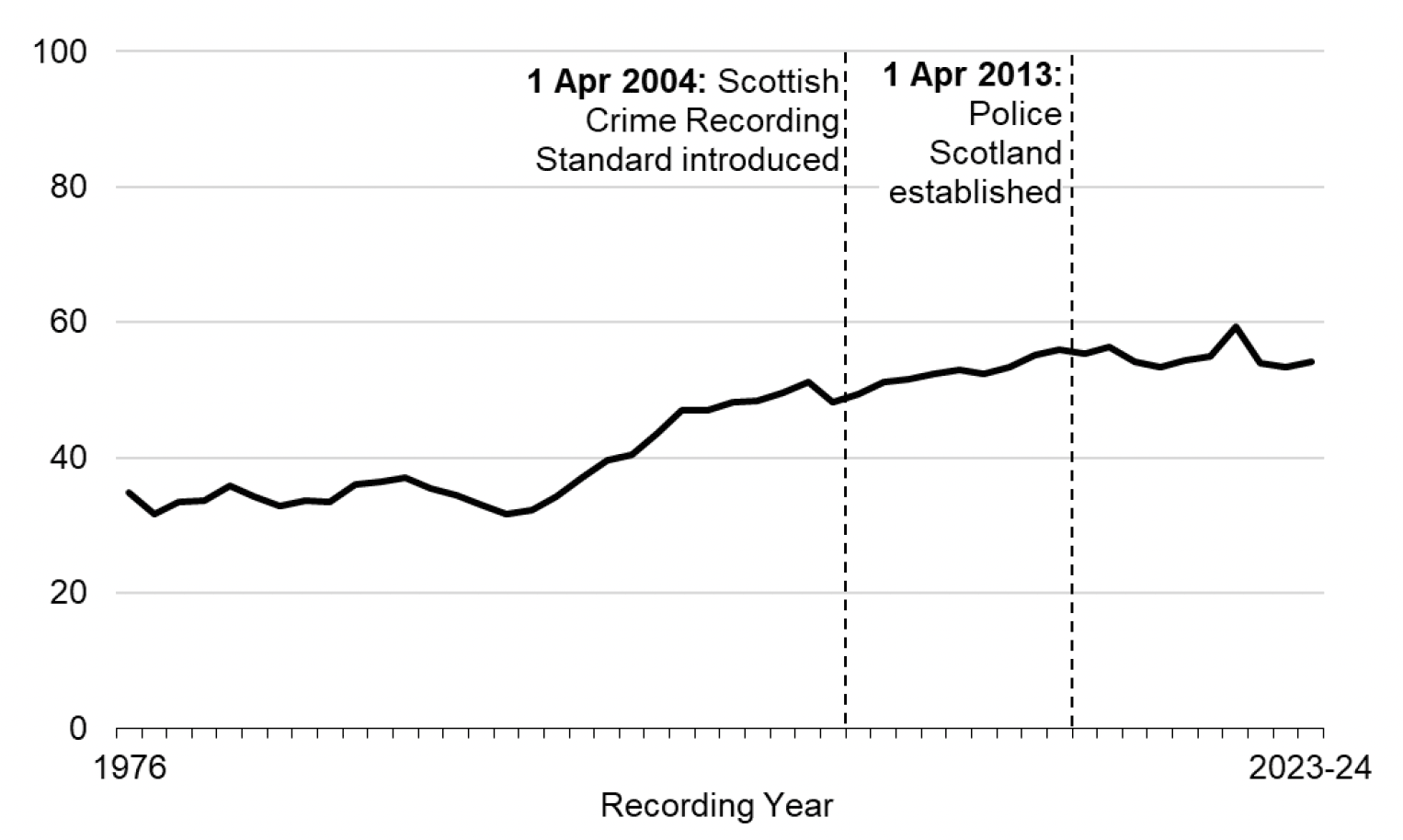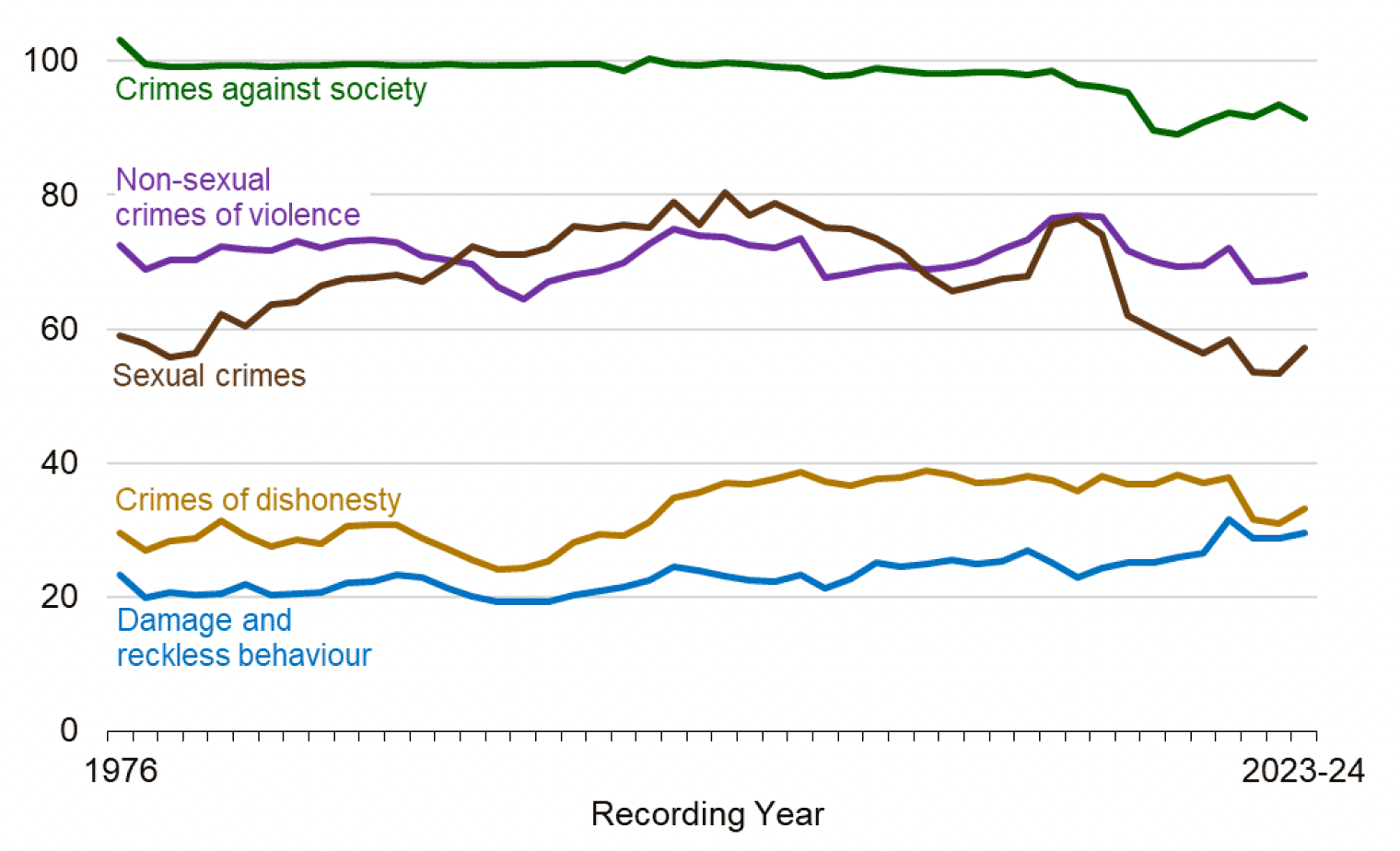Recorded Crime in Scotland, 2023-24
Statistics on crimes and offences recorded and cleared up by the police in Scotland in 2023-24, split by crime or offence group and by local authority.
Official Statistics on clear up rates
This section presents statistics on recorded crime clear up rates in Scotland during 2023-24. Whereas the rest of this bulletin presents recorded crime statistics that have been produced as Accredited Official Statistics, these clear up rate statistics remain published as Official Statistics.
A crime or offence is regarded as cleared up where there exists a sufficiency of evidence under Scots law to justify consideration of criminal proceedings notwithstanding that a report is not submitted to the procurator fiscal because either:
(i) by standing agreement with the procurator fiscal, the police warn the accused due to the minor nature of the offence, or
(ii) reporting is inappropriate due to the non-age of the accused, death of the accused or other similar circumstances.
Clear up rates are calculated as follows:

Clear up rates presented are rounded to one decimal place.
Because crimes or offences may be cleared up in a different year than they were recorded, rates in excess of 100% can arise.
Clear up rates for both the Coronavirus restrictions crimes group and Road traffic offences group are not included in this bulletin, as by their nature both typically involve criminality in which the offender is ‘caught in the act’. Further to this, it has not been possible to obtain clear up rate information for the Coronavirus restrictions group, due to the separate and bespoke data collection used by Police Scotland. Further detail on clear up rates by groups and categories is available from the 'Supporting documents' Excel workbook (Table 3).
More information on clear up rates is available in the User Guide.
Total recorded crime
In 2023-24 the clear up rate was 54.1%, up from 53.3% in 2022-23 and back to a similar level seen in 2021-22.
The large decrease seen between 2020-21 and 2021-22 likely reflected the impact of the COVID-19 pandemic on the types of crime recorded, with the volume of those crimes that have relatively lower clear up rates falling more sharply in 2020-21 than those with relatively higher clear up rates. The fall to 54.0% in 2021-22 from 59.3% in 2020-21 reflected a partial return to the volume of different crime types recorded prior to the pandemic (2019-20).
Clear up rates have remained relatively stable in 2023-24, increasing slightly from 53.3% to 54.0%. Crimes against society (91.4%), Non-sexual crimes of violence (68.0%) and Sexual crime (57.2%) continued to have higher clear up rates in 2023-24 than Crimes of dishonesty (33.1%) and Damage and reckless behaviour (29.6%).
Prior to 2020-21, clear up rates had been relatively stable over the last decade following a generally upward trend since 1976, the first year for which comparable clear up rates are available, as shown by Chart 16 below.
Total clear up rate for recorded crime in Scotland has generally increased over the years.

Chart 17 shows the clear up rates by crime group from 1976 onwards.
Crimes against society has had the highest clear up rate in each year since 1976.

Non-sexual crimes of violence
The clear up rate for Non-sexual crimes of violence increased from 67.3% in 2022-23 to 68.0% in 2023-24.
Between 2022-23 and 2023-24, the category with the largest increase was Murder and culpable homicide, from 91.7% to 106.9%. Other non-sexual violence had the largest decrease, from 40.2% to 38.6%. Serious assault and attempted murder had the only other decrease, from 79.9% to 79.4%.
Sexual crimes
The clear up rate for Sexual crimes increased from 53.4% in 2022-23 to 57.2% in 2023-24.
Between 2022-23 and 2023-24, clear up rates increased for most categories. The category with the largest increase was Communicating indecently, from 57.2% to 65.0%. Crimes associated with prostitution had the largest decrease, from 80.6% to 75.0%.
Crimes of dishonesty
The clear up rate for Crimes of dishonesty increased from 31.0% in 2022-23 to 33.1% in 2023-24.
Between 2022-23 and 2023-24, clear up rates increased for most categories. The category with the largest increase was Theft of a motor vehicle, with the clear up rate increasing from 38.4% to 42.4%. The category with the largest decrease was Theft by opening lockfast places, decreasing from 23.5% to 18.7%.
Damage and reckless behaviour
The clear up rate for Damage and reckless behaviour increased from 28.8% in 2022-23 to 29.6% in 2023-24. Damage and reckless behaviour consistently has the lowest clear up rate of the five crime groups. However, despite the decrease in 2021-22, which remained unchanged in 2022-23, there were year-on-year increases between 2014-15 and 2020-21. The rate for 2023-24 is the second highest over the past ten years.
Between 2022-23 and 2023-24, the only decrease occurred in the clear up rate for the Fire-raising category, from 29.5% to 25.7%.
Crimes against society
The clear up rate for Crimes against society decreased from 93.4% in 2022-23 to 91.4% in 2023-24. Clear up rates for Crimes against society have always been the highest of all groups, as many of the contributing categories (though not all) relate to criminality for which someone is generally ‘caught in the act’ (for example Drugs – Possession). An example of where this is not the case would be the Weapons Possession (used) category, where earlier research[9] suggested the clear majority of crimes were recorded following a victim or witness report to the police.
There were consistent decreases in clear up rates for Crimes against society between 2014-15 and 2018-19, followed by small increases over 2019-20 and 2020-21. Since 2020-21, clear up rates for Crimes against society have fluctuated.
Between 2022-23 and 2023-24, most categories have seen an increase. The category with the largest increase was Other crimes against society, with the clear up rate increasing from 82.3% to 102.6%. The category with the largest decrease was Drugs – Possession, with the clear up rate decreasing from 100.8% to 94.2%. Drugs – Supply had the only other decrease, from 88.9% to 88.5%.
Contact
Email: Justice_Analysts@gov.scot
There is a problem
Thanks for your feedback